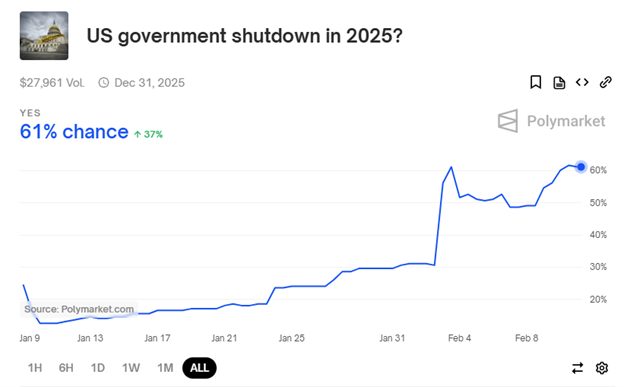There are just four weeks left to avoid a government shutdown, but some in Washington seem more interested in playing the blame game or resisting rather than finding a solution.
The government is currently running on a temporary funding measure called a “continuing resolution.” That resolution expires on March 14 – on that date, the government will shut down unless Congress passes a budget or another extension.
A government shutdown would not be catastrophic, but there would be serious consequences:
Service members’ pay could be delayed
Air safety investigations at the National Transportation Safety Board could be disrupted
Environmental and food safety inspections could halt
Food and health assistance programs could be paused
Millions of federal employees would be furloughed with no guarantee of back pay
So, will we see a government shut down this year?
One way to approach this question is to follow the crowd. Bettors at the prediction market website Polymarket suggest there is a 61 percent chance the government shuts down at some point in 2025.
Another approach is to look at history. Prior to 2025, there have been three years where President Trump had a Republican-controlled Congress. In two of those three years, the government shut down – including the longest shutdown in U.S. history in 2019.
So, Republican control of all three branches of government doesn’t necessarily protect against a shutdown. But there is a silver lining: 2017 is the most similar year to 2025, and Congress was able to avoid a shutdown then.
Just like 2025, 2017 was the first year of President Trump’s term. In both years, he took office with a continuing resolution in effect. And in both years, President Trump had slim majorities to work with in the Senate; Republicans had 52 seats in 2017 compared to 53 today.
In 2017, Congress finally passed a budget in May and avoided a shutdown. But Republicans could not do it alone; it takes 60 votes to overcome a filibuster in the Senate, and the far-right flank in the House refused to cooperate on nearly anything.
In both chambers, it would take a bipartisan deal to get the budget passed. Leaders of both parties agreed to compromise. Republicans got $15 billion in additional defense spending and $1.5 billion for border security (excluding President Trump’s border wall). Democrats ensured there was no funding for the border wall, no hiring additional ICE agents, and no defunding of sanctuary cities.
Neither party got everything they wanted, but, in the end, nearly all Democrats and most Republicans in both chambers voted for the budget and kept the government running.
If Washington wants to avert a shutdown this year, leaders must once again be open to negotiation, compromise, and putting the country’s needs over their desire to score political points.






You are still wasting time and money. Please get a presidential ticket together and give us the third party choice we need.
Great article! Hopefully a government shutdown can be averted however there needs to be significant spending cuts made. If Democrats cannot agree to significant cuts than there may be no other choice.